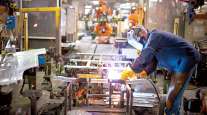Senior Reporter
Class 8 Orders Reach 20,000, Hit Reset Button

[Stay on top of transportation news: Get TTNews in your inbox.]
North American Class 8 orders in December reached 20,000, according to industry analysts citing preliminary data. The volume underscored what they said was a reset to a more typical ordering pattern, although some see orders in 2020 as more susceptible to downside risk than upside gain.
The net order number will be available later in the month once truck makers issue the final report, which typically tracks closely with the preliminary number.
A year earlier, orders hit 21,381 but spent 10 months of 2019 coming in below replacement levels — seen as 19,000 units. That followed the tremendous surge in Class 8 orders in 2018 when they hit 490,100, smashing the previous high of 390,000 in 2004, according to ACT.

Tam
“We finally start shrinking the fleets this year, helping to accelerate the balancing of capacity between trucks and freight,” ACT Vice President Steve Tam told Transport Topics.
“It goes back to almost a food-chain thing. You look at the big publicly traded guys, and while they are not making as much money as they did a year or two ago, they are still making money,” he said. “It’s the smaller fleets, the owner-operators who are disappearing from the landscape who represent the rightsizing of capacity.”
FTR pegged orders at 20,000, too.
“You had the big run up, the big run down, and this is the reset,” said Don Ake, FTR’s vice president of commercial vehicles. At the same time, there is too much inventory sitting on dealer lots for the level of demand, he said.
One truck maker agreed.
“The industry is still facing high inventory levels, which means many dealers won’t order stock units until that situation has improved,” said Magnus Koeck, vice president of marketing and brand management for Volvo Trucks North America. “We continue to monitor the situation and adjust our capacity based on customer demands.”
VTNA is a unit of Volvo Group.

Ake
Meanwhile, freight growth has stalled and created a pretty flat market, and there’s a lot of negatives associated with that, Ake said, creating “probably” more downside risk than upside gain. “This market doesn’t stay this stable for long. There could be forces that are unforeseen at this point that could knock it out of balance again. I don’t see a big jump forward in the election year.”
Some negative changes already have happened. Workers have been let go at various truck plants and suppliers as demand and the backlog drops off. Plus, truck makers and suppliers are not making as much money as during the run-up.
“If things pick up and the market is slow to respond, then we go back into the industry running behind” the market, Ake said.
One truck dealer executive said he believes truck makers are “scrambling” to keep the factories up and running and offering incentives to accomplish this. For the dealers that have excess inventory on the lot, the deals on trucks coming off the line could make it difficult to sell existing inventory if the sales force is given an incentive to order a truck.
“There is no longer the sense of urgency due to shorter lead times” to get a truck, said Robert Gomez, executive vice president of sales for Worldwide Equipment. That compares with ordering a truck a year ago, when the backlog pushed delivery dates out by several months to a year.
The Prestonsburg, Ky., company is a truck and trailer dealer representing multiple brands, including Mack Trucks, VTNA, Kenworth Truck Co., International, Hino Trucks and Isuzu. The company operates in six states and has 16 full-service dealerships and 15 leasing locations, among other facilities.
The ones ordering today are more the private fleets, Gomez said. “They are hauling their own freight, and the economy is still strong. Obviously, the election has the potential to take some wind out of the sails, so to speak, in the middle to end of the year,” he said.
Gomez added that Worldwide’s business with private fleets has increased because last year, those fleets were shut out of buying some trucks and forced to reorganize their needs and buying schedules.
Mack Trucks, also a unit of Volvo Group, said although its orders were rising, customers are shifting to replacement levels.
“This shift is the result of moderating economic indicators, including manufacturing, freight volumes and consumer spending, as well as an industry order backlog that is now more in line with historical norms. We anticipate this will continue through 2020, resulting in total North American production of 240,000 trucks,” said Jonathan Randall, Mack Trucks senior vice president of North American sales and marketing.
ACT is looking for orders this year of 17,000 or 18,000 units per month to support its North American production forecast for 2020 of 216,000 units in all.
Want more news? Listen to today's daily briefing:




